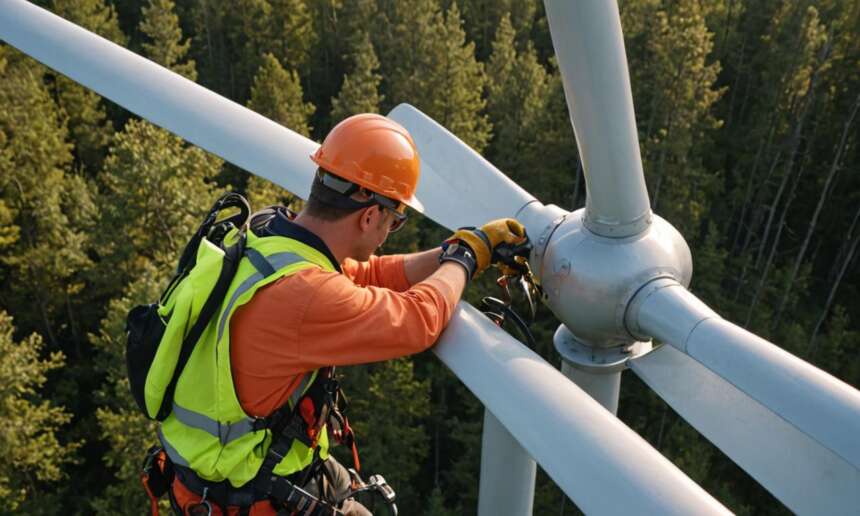If you’re intrigued by the idea of working in the renewable energy sector and want to play a crucial role in harnessing wind power, becoming a wind turbine technician could be an excellent career choice. Wind turbine technicians, also known as windtechs, are responsible for the installation, maintenance, and repair of wind turbines, ensuring they operate efficiently and safely to generate clean energy. Here’s a comprehensive guide on how to kickstart your journey towards becoming a proficient wind turbine technician.
Educational Requirements
While a formal degree isn’t always mandatory, having a background in relevant fields such as electrical or mechanical engineering, renewable energy technology, or wind turbine technology can significantly enhance your prospects in this field. Consider pursuing an associate’s or bachelor’s degree from a reputable institution to gain a solid foundation of knowledge and skills relevant to wind turbine technology.
Gain Practical Experience
Hands-on experience is invaluable in the field of wind turbine technology. Look for internships, apprenticeships, or entry-level positions with wind energy companies or contractors. This practical exposure will not only provide you with essential skills but also give you a glimpse into the day-to-day operations of wind farms.
Obtain Certifications
While not always mandatory, obtaining certifications can boost your credibility and competitiveness in the job market. Consider pursuing certifications such as the American Wind Energy Association (AWEA) Wind Turbine Technician Certification or the Global Wind Organisation (GWO) Basic Safety Training. These certifications demonstrate your proficiency in safety protocols and technical knowledge specific to wind turbine maintenance and repair.
Develop Technical Skills
Wind turbine technicians require a diverse skill set to effectively troubleshoot, repair, and maintain wind turbines. Familiarize yourself with electrical systems, hydraulic systems, mechanical components, and computerized monitoring systems commonly found in wind turbines. Additionally, honing skills such as climbing, rigging, and working at heights is crucial for safely accessing turbine components.
Stay Updated with Industry Trends
The renewable energy sector, including wind energy, is continuously evolving with advancements in technology and practices. Stay informed about the latest developments, innovations, and best practices through industry publications, workshops, conferences, and online resources. Continuous learning and adaptability are essential traits for success in this dynamic field.
Network and Build Relationships
Networking plays a vital role in advancing your career in any industry, and the wind energy sector is no exception. Attend industry events, seminars, and job fairs to connect with professionals already working in the field. Building relationships with industry insiders can provide valuable insights, job leads, and mentorship opportunities.
Apply for Positions
Once you’ve acquired the necessary education, experience, and certifications, start applying for wind turbine technician positions. Tailor your resume to highlight relevant skills and experiences, and don’t hesitate to showcase any hands-on experience or projects related to wind energy technology. Be prepared for interviews by researching the company and industry trends, and demonstrate your enthusiasm and commitment to the role.
Continuously Improve and Grow
The field of wind turbine technology is dynamic and ever-changing. Stay proactive in seeking opportunities for professional development, whether through additional certifications, advanced training programs, or pursuing higher education. By continuously improving your skills and knowledge, you’ll remain competitive and adaptable in this fast-paced industry.
Becoming a wind turbine technician requires a combination of education, hands-on experience, technical skills, and a passion for renewable energy. By following these steps and remaining dedicated to your career goals, you can embark on a fulfilling journey in the wind energy sector, contributing to a sustainable future for generations to come.
Frequently Asked Questions
Here are some commonly asked questions about becoming a wind turbine technician:
| Question | Answer |
|---|---|
| 1. Is a formal degree necessary to become a wind turbine technician? | While not always mandatory, having a degree in relevant fields such as electrical or mechanical engineering can enhance your prospects in this field. |
| 2. What certifications are recommended for wind turbine technicians? | Consider pursuing certifications such as the American Wind Energy Association (AWEA) Wind Turbine Technician Certification or the Global Wind Organisation (GWO) Basic Safety Training. |
| 3. How important is practical experience? | Hands-on experience is invaluable as it provides essential skills and insight into the day-to-day operations of wind farms. |
| 4. What technical skills are essential for wind turbine technicians? | Technical skills such as familiarity with electrical systems, hydraulic systems, mechanical components, and computerized monitoring systems are crucial. |
| 5. How can I stay updated with industry trends? | Stay informed through industry publications, workshops, conferences, and online resources to remain aware of the latest developments and best practices. |
Salary and Job Outlook
Wind turbine technicians typically earn competitive salaries, with opportunities for growth as the demand for renewable energy continues to rise. According to the U.S. Bureau of Labor Statistics, the median annual wage for wind turbine technicians was $56,230 in May 2020. The job outlook for this profession is also promising, with employment projected to grow much faster than average.
Environmental Impact
One of the key benefits of working in the wind energy sector is the positive environmental impact. Wind power is a clean and renewable energy source that helps reduce greenhouse gas emissions and reliance on fossil fuels, contributing to a more sustainable future.




